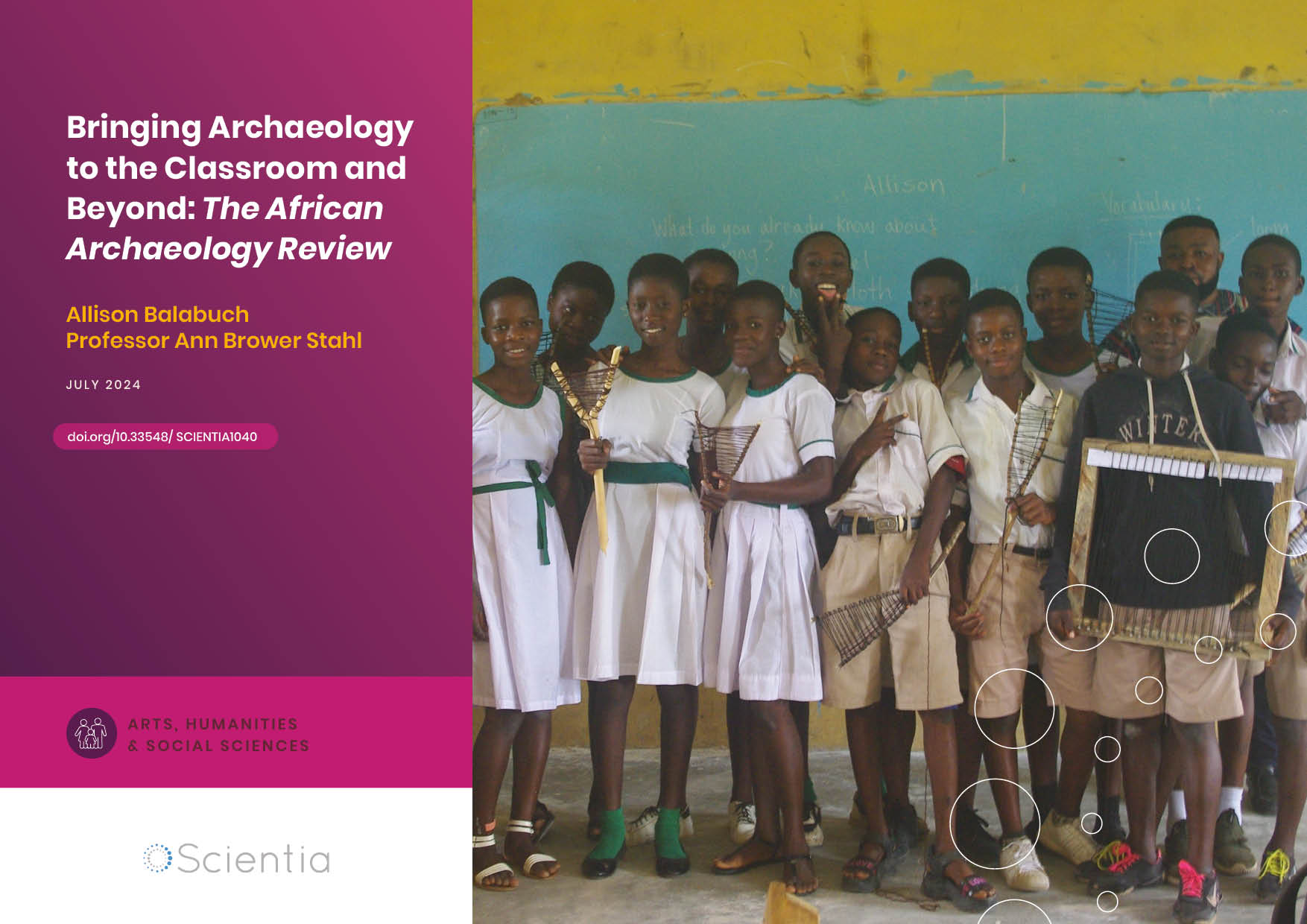Professor Hyun-Joon Ha – Building Diverse Medicinal Compounds from Aziridines
The artificial synthesis of medicinal compounds that are typically derived from natural sources helps scientists to better understand how they function and deduce whether they can be enhanced. Unfortunately, the work involved in synthesising such natural compounds and their analogues is extremely difficult. Professor Hyun-Joon Ha and his team from Hankuk University of Foreign Studies in the Republic of Korea are exploring ways to transform compounds called aziridines into a range of biologically active molecules.
From Aziridines to Alkaloids
A class of nitrogen-containing organic compounds, known as ‘alkaloids’, represent the majority of all naturally occurring medicinal compounds – from morphine to numerous anti-cancer drugs. Alkaloids have repeatedly been shown to treat a large variety of ailments and conditions. Unfortunately, the supply of naturally occurring compounds is very limited. Additionally, in the case of many alkaloids, the way in which they function is largely a mystery.
Artificially synthesising alkaloids is one way to address the short supply of these important compounds, while also providing scientists with a better understanding of how they work. The path, however, to prepare copies of naturally occurring alkaloids involves multiple stages and is quite challenging.
Part of the challenge is due to the complex ‘stereochemistry’ of alkaloids. Stereochemistry refers to the relative spatial arrangement of atoms within a molecule. It describes how two molecules made up of the same number and types of atoms can, for example, exist as a ‘left-hand’ version and a ‘right-hand’ version. In this analogy, both hands have the same number and types of fingers, but they have different three-dimensional structures.
Stereochemistry is a fundamental component of biological systems. With the multitude of biochemical processes taking place at any given time, stereochemistry allows for control over which processes are triggered. This can be realised if a biochemical process requires a specific ‘hand’, in other words, a molecule with a unique three-dimensional form, in the same way as a mechanical lock requires a specific key. This is why all biologically active alkaloids have stereochemical properties: to ensure greater control.
A significant challenge faced by synthetic chemists is that the pathway needed to produce the desired ‘hand’ often results in a mixture of both right and left hands. When both versions of a molecule are produced in the same mixture then considerable effort is required to separate them.
To get a head-start, some chemists start with smaller, more readily available compounds that already have some of the stereochemistry required to build the desired version of an alkaloid. Professor Hyun-Joon Ha and his team from the Hankuk University of Foreign Studies in the Republic of Korea are interested in the development of new routes to alkaloids, by starting the synthetic process from a class of compounds known as ‘aziridines’.
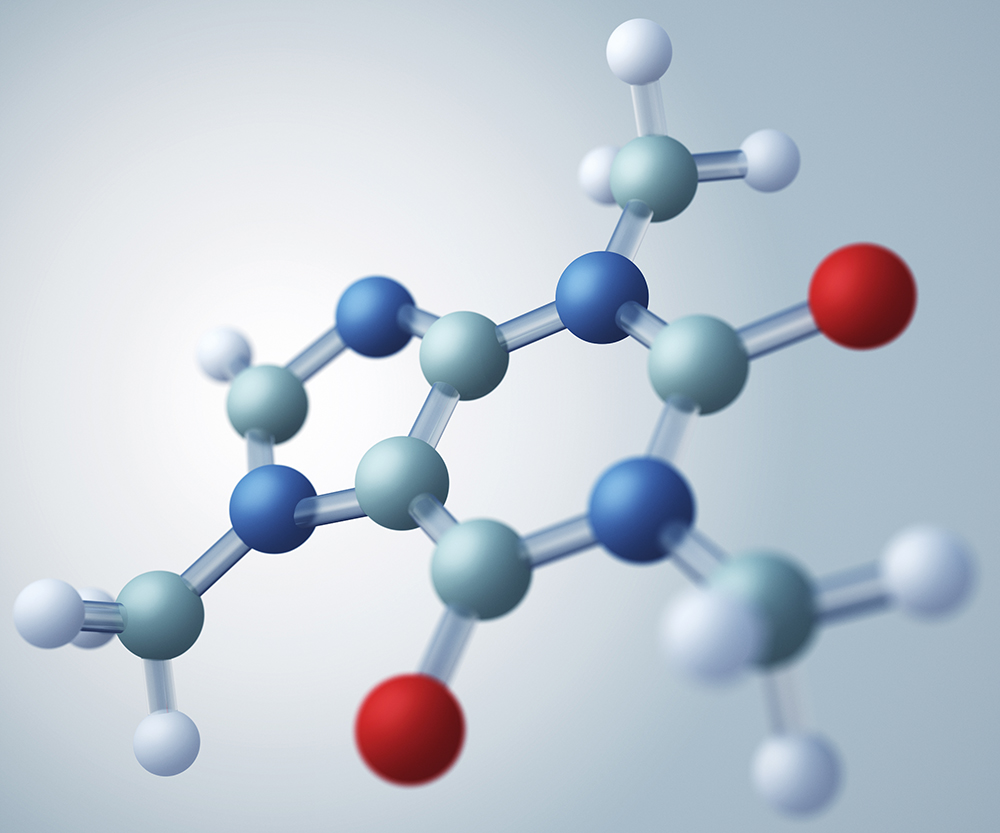
Left- and Right-hand Aziridines
Aziridines are compounds containing a ring composed of two carbon atoms and one nitrogen atom. They, like alkaloids, can possess stereochemical properties. Some aziridines can exist as a left-hand version and a right-hand version. Atoms bonded to the ring reside on one side of the ring only, introducing stereochemistry to the molecule.
As part of Professor Ha’s synthetic route to prepare alkaloids, the aziridine ring must be opened. When this occurs, the orientation of the atoms bonded to the ring is preserved. This is what makes aziridines particularly useful in the preparation of alkaloids. Professor Ha’s team utilises the stereochemical properties of aziridines that bear spatially unique groups to help them synthesise alkaloids with the desired stereochemistry.
Another challenge for the team is to choose an appropriate aziridine that will eventually lead to the required alkaloid. As is the case with many research projects of this scope, Professor Ha and his colleagues plan each step by first considering the chemical structure of the alkaloid they want to synthesise. They then work backwards from the product, rearranging the bonds on paper to visualise what the previous step would look like. This analysis is repeated until they reach a compound that looks like an aziridine. The overall analysis, referred to as ‘retrosynthesis’, helps the team to decide which aziridine to use.
Cancer Treatment and Mosquitos
One of the alkaloids of interest to Professor Ha’s team is known as ‘Microgrewiapine A’. This compound is known to target cancerous colon cells in humans while ignoring healthy cells. Microgrewiapine A can be extracted from the stem bark, branches and leaves of the orange jasmine tree, which is commonly found in many parts of south Asia.
Regarding the chemical structure, the Microgrewiapine A molecule contains a ring composed of five carbon atoms and one nitrogen atom. An aziridine ring is composed of three atoms, so during the synthesis, the team had to open the aziridine ring and then close a chain of atoms to form a larger, six-membered ring. Impressively, they were able to isolate the left-hand and right-hand versions of Microgrewiapine A. Through a detailed analysis, the team confirmed which version exists in nature by comparing the natural form of Microgrewiapine A with their synthetic forms.
The overall process of converting the required aziridine compound into Microgrewiapine A is significant undertaking. Quite often, chemists will aim to synthesise one alkaloid while remaining open to the possibility of synthesising other alkaloids with similar structures. This approach takes advantage of the lessons learned in making one alkaloid, and can be more productive from a research standpoint.
During the synthesis of Microgrewiapine A, Professor Ha and his colleagues were also able to record the preparation of other alkaloids that contain a six-membered ring. The team achieved this by making very small adjustments to some of the steps involved. One of the other alkaloids produced is known as ‘Microcosamine A’. This alkaloid was first extracted from the leaves of a shrub found in China called Microcos paniculate, and is used in traditional medicine to treat digestion related ailments. Microcosamine A is also known to have insecticidal properties and can effectively target the larvae of mosquitos. Remarkably, the only difference in the chemical structure of these two alkaloids is the presence of a few additional atoms bonded to the six-membered ring in Microgrewiapine A.
‘However, we found versions of handedness, as left-hand and right-hand versions of natural Microgrewiapine A and Microcosamine A are opposites,’ says Professor Ha. ‘This was achieved with measurements of the optical rotation of the molecules.’
The synthesis of both Microgrewiapine A and Microcosamine A was a first for the community and a major achievement for Professor Ha’s team. The process involved at least eight steps starting from the required aziridine. The complexity of this feat also demonstrates the power and control of plants, which can produce such diverse compounds, using only water, carbon dioxide, sunlight and minerals drawn from the soil.
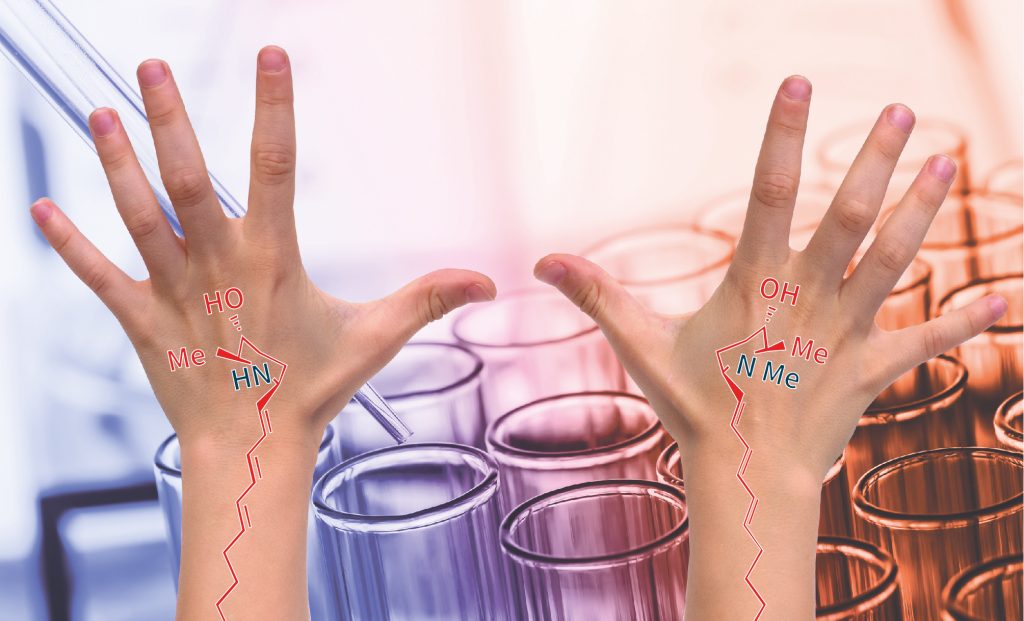
Spruce Trees, Fire Ants and Bacteria
The six-membered ring described above is also a key component of many other alkaloids. Professor Ha and his colleagues have published the synthetic pathway needed to produce the compounds ‘dihydropinidine’ and ‘isosolenopsin’. Dihydropinidine is an alkaloid that functions as a defence chemical of evergreen spruce trees found in North America, and can also be found in the Mexican ladybird beetle. Isosolenopsin can be extracted from fire ants’ venom and is known to exhibit numerous properties. These include the breakdown of red blood cells, antibiotic activity against bacteria as well as antifungal properties.
Structurally, both dihydropinidine and isosolenopsin have the same six-membered ring found in Microgrewiapine A and Microcosamine A, described previously. The key steps involved in the synthesis of dihydropinidine and isosolenopsin were also similar. The team had to open the aziridine ring and then eventually close a chain of atoms to form the six-membered ring.
To keep the synthetic procedures as simple as possible and reduce chemical waste, they performed many of the reactions in one vessel. This approach to chemical synthesis is known as a ‘one-pot’ procedure and is generally much quicker and easier than performing each step in a different vessel. About 50% of the aziridine was converted into the alkaloid, which is a commendable achievement given that the process involves at least four steps.
Another significant finding for Professor Ha and his team was the synthesis of ‘biemamide B’ and ‘biemamide D’, which was another first for the community. Both alkaloids have been extracted from bacteria and are known to prevent the transformation of healthy human cells into cancerous cells. This time, the ringed structure found in both alkaloids is composed of four carbon atoms and two nitrogen atoms.
As with all other examples presented, the researchers started from the required three-membered aziridine ring and, following multiple stages, eventually synthesised the desired biemamide alkaloid. In addition, the team was able to confirm which hand was present in nature, by comparing the analytical data of their synthesised forms of bienamide B and D with the naturally derived forms of each alkaloid.

A Promising Future
In conclusion, Professor Ha and his colleagues have made significant progress in the synthesis, structural identification and understanding of a range of medicinal alkaloids, built using commercially available aziridines. They hope that their work will increase the availability and reduce the cost of these important compounds, towards improving people’s access to life-saving medicine.
Reference
https://doi.org/10.33548/SCIENTIA655
Meet the researcher
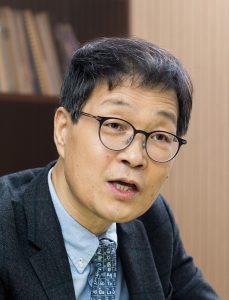
Professor Hyun-Joon Ha
Chemistry Department
Hankuk University of Foreign Studies
Yongin
South Korea
Professor Hyun-Joon Ha earned his PhD in chemistry in 1987 from Brown University in the US. Following his postdoctoral work at Stanford University, he joined the Chemistry Department at Hankuk University of Foreign Studies in Seoul, South Korea, in 1991. Professor Ha’s research interests include the exploitation of new methods in organic synthesis. He has recently become interested in medicinal chemistry for drug discovery, process development for pharmaceuticals, and the design and synthesis of radiopharmaceuticals. He has also taken up several, fixed-period, senior administrative assignments, as the Dean of Natural Science at Hankuk University of Foreign Studies and as the 51st President of the Korean Chemical Society.
CONTACT
E: hjha@hufs.ac.kr
KEY COLLABORATORS
Professor Won Koo Lee, Sogang University
Professor Matthias D’hooghe, Ghent University
FUNDING
National Research Foundation of Korea (2020R1A2C1007102, 2012M3A7B4049645 and 2021R1A5A6002803 with the Centre for New Directions in Organic Synthesis)
FURTHER READING
N Srivastava, L Macha and H-J Ha, Stereoselective synthesis of 2,6-disubstituted piperidine alkaloids, Organic and Biomolecular Chemistry, 2020, 18, 5493.
N Srivastava, L Macha, and H-J Ha, Total Synthesis and Stereochemical Revision of Biemamides B and D, Organic Letters, 2019, 21, 8992.
L Macha and H-J Ha, Total Synthesis and Absolute Stereochemical Assignment of Microgrewiapine A and Its Stereoisomers, Journal of Organic Chemistry, 2019, 84, 94.
NN Yadav, J Choi and H-J Ha, One pot multiple reactions: asymmetric synthesis of 2,6-cis-disubstituted piperidine alkaloids from chiral aziridine, Organic and Biomolecular Chemistry, 2016, 14, 6426.

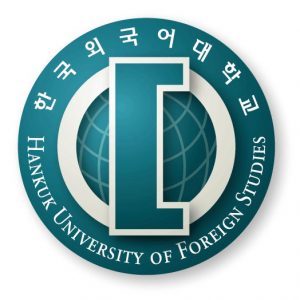
Want to republish our articles?
We encourage all formats of sharing and republishing of our articles. Whether you want to host on your website, publication or blog, we welcome this. Find out more
Creative Commons Licence
(CC BY 4.0)
This work is licensed under a Creative Commons Attribution 4.0 International License. 
What does this mean?
Share: You can copy and redistribute the material in any medium or format
Adapt: You can change, and build upon the material for any purpose, even commercially.
Credit: You must give appropriate credit, provide a link to the license, and indicate if changes were made.
More articles you may like
Dr Ralf Adam | New Technologies Shaping the Future of Oral Hygiene
Understanding the efficiency of various toothbrush technologies is essential for achieving optimal oral health. Dr Ralf Adam, who leads a dedicated team at Procter & Gamble in Germany, is keen to investigate the complexities of these technologies. His team have provided new insights into the best toothbrush types for plaque removal and the maintenance of gum health. By highlighting the importance of informed oral care decisions and ongoing investigations, this vital research works towards ensuring everyone can achieve a brighter, healthier smile.
WVU ADVANCE Center | West Virginia University Team Fosters Group-Level Equity and Inclusivity at Higher Education Institutions
Despite ongoing efforts to broaden participation in the academy, many groups remain underrepresented. More needs to be done to ensure that all faculty and students succeed in institutions of higher education. The WVU ADVANCE Center is an academic hub at West Virginia University, which provides services, events, mentorship opportunities, and other initiatives that promote the sense of belonging that leads to thriving faculty and students.
Dr Olalla Castro-Alvaredo | Measuring Entanglement: Symmetry-Resolved Entropy
Dr Olalla Castro-Alvaredo of the City University of London (UK) and her collaborators are advancing our understanding of an important phenomenon of quantum mechanical systems known as entanglement and, especially, its mathematical measures. Symmetry-resolved entanglement entropy is one such measure. Their study focuses on special quantum states which are excited with respect to a ground state. The research shows how the entanglement amongst quantum particles can be measured and assesses the contribution to the entanglement of quasiparticle excitations, particularly in the presence of additional symmetries.
Allison Balabuch – Professor Ann Brower Stahl | Bringing Archaeology to the Classroom and Beyond: The African Archaeology Review
The African Archaeology Review (AAR) journal recently celebrated its 40th anniversary. To mark this occasion, a special issue was compiled with an innovative theme: Archaeology for Education. To achieve this, the AAR editorial team assembled a group of academic researchers in archaeology with the proposition of writing articles collaboratively with educators that would make their research centred on Africa’s rich pasts accessible for use in school learning. The goal is to change the stories we tell about Africa both within and outside the continent.




